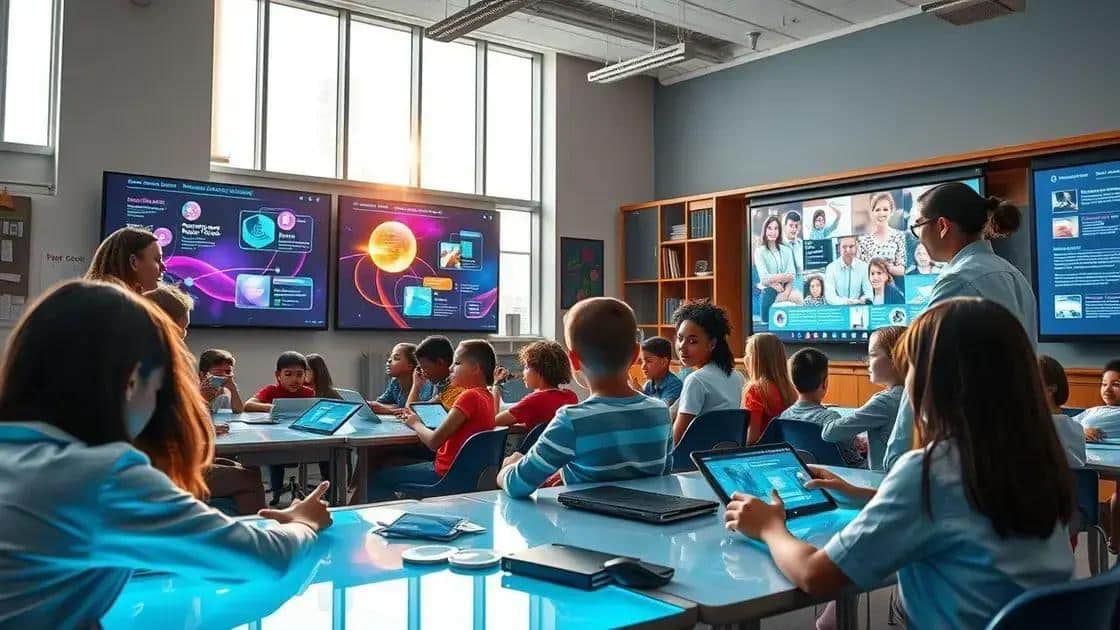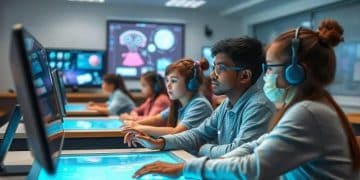Insights on teacher ai tools 2025

Insights on teacher AI tools in 2025 highlight their role in enabling personalized learning, improving student engagement, and facilitating collaboration, ultimately transforming the educational experience.
Insights on teacher AI tools 2025 show a landscape where technology shapes education. Have you ever wondered how AI can enhance teaching methods and student engagement? Let’s dive into the possibilities.
Understanding teacher AI tools
Understanding teacher AI tools is essential in today’s educational landscape. These tools are designed to assist educators in enhancing their teaching methods and improving student outcomes. By integrating artificial intelligence into the classroom, teachers can simplify administrative tasks and focus more on student engagement.
Key Features of Teacher AI Tools
One major advantage of these tools is the ability to tailor learning experiences to individual students. This personalization can lead to more effective learning outcomes. Additionally, teacher AI tools can provide real-time feedback, helping educators assess student progress. Here are some key features:
- Adaptive Learning: Adjusts content based on student performance.
- Data Analytics: Offers insights into student learning patterns.
- Automation: Reduces time spent on grading and administrative tasks.
- Resource Recommendations: Suggests learning materials tailored to students’ needs.
Moreover, these tools can facilitate collaboration among students. Through AI-driven platforms, students can work together on projects, sharing ideas and resources in real-time. This collaborative approach not only enhances learning but also builds teamwork skills that are crucial in today’s job market.
Integrating AI Into the Classroom
Integrating AI tools in teaching is not just about technology; it’s also about changing how educators connect with their students. Teachers can create a dynamic learning environment by using AI to support various teaching strategies. This can include interactive video lessons, gamified learning experiences, and instant assessments. The ultimate goal is to make learning more engaging and effective.
Ultimately, understanding teacher AI tools opens up a world of possibilities. They empower teachers to enhance their skills and, in turn, provide better education for their students. By embracing these innovations, educators can stay ahead in a rapidly changing educational landscape.
Benefits of AI tools for educators

Exploring the benefits of AI tools for educators reveals how these innovative technologies are transforming the teaching landscape. By leveraging AI, teachers can enhance their effectiveness, making the learning experience more engaging for students.
Enhanced Teaching Efficiency
One of the most significant advantages is the ability to automate routine tasks. This allows educators to spend more time focusing on teaching rather than administrative duties. Here are some key benefits:
- Time Savings: AI can manage scheduling, grading, and feedback, freeing up precious time.
- Real-Time Insights: Educators receive immediate data on student performance, helping them adjust their teaching strategies quickly.
- Personalization: AI tools allow for customized learning experiences for each student, catering to their unique needs.
- Scalability: These tools help educators manage larger classrooms without sacrificing quality of education.
In addition, AI tools can support differentiated instruction. Teachers can identify which students need more help in specific areas and tailor their lessons accordingly. This targeted approach increases the chances of every student succeeding by addressing their individual challenges.
Improved Student Engagement
Another benefit of AI tools for educators is the potential to boost student engagement. Interactive AI applications can make learning more enjoyable. Examples include gamified learning modules and virtual simulations that captivate students’ interest. These technologies encourage active participation, leading to better learning outcomes.
Moreover, teachers can use AI to help track student engagement levels. By analyzing data from AI tools, they can identify trends and modify their teaching methods to enhance involvement, ensuring no student is left behind. The integration of these tools can help create a vibrant learning environment that inspires creativity and curiosity.
How to effectively integrate AI in the classroom
Integrating AI in the classroom is an exciting venture that promises to enhance teaching and learning. When done effectively, AI tools can create a dynamic educational environment that benefits both teachers and students.
Developing A Clear Strategy
A successful integration starts with having a clear plan. Educators should assess their needs and set specific goals for what they want to achieve with AI. This might involve improving student engagement, providing personalized learning experiences, or automating administrative tasks. Having clear objectives will guide the integration process.
- Identify Educational Goals: Determine what you hope to achieve with AI tools.
- Research Available Tools: Explore different AI solutions that align with your needs.
- Train Educators: Ensure teachers are comfortable and knowledgeable about using AI.
- Gather Feedback: Continuously collect student and teacher feedback to refine strategies.
Another essential aspect is to start small. Instead of trying to implement multiple AI tools at once, teachers can begin with one or two applications that suit their curriculum. This gradual approach facilitates smoother adoption and allows time for evaluation and adjustments.
Encouraging Collaboration and Engagement
Collaboration among students is key when integrating AI in the classroom. Using AI tools can facilitate group projects where students collaborate and interact in real-time. For example, platforms that enable collaborative document editing or brainstorming can foster teamwork and critical thinking skills as students engage with each other’s ideas.
Additionally, to maximize student engagement, teachers should incorporate interactive AI applications that captivate attention. Interactive simulations or gamified activities can make learning fun while reinforcing essential concepts. By providing these engaging experiences, educators can motivate students to participate actively in their learning.
Future trends in educational AI

The future trends in educational AI promise to reshape how we approach learning and teaching. As technology advances, the role of AI in education will continue to expand, introducing innovative methods to enhance educational outcomes.
Personalized Learning Experiences
One trend is the growth of personalized learning experiences. AI tools can analyze student data to create customized learning paths that cater to individual strengths and weaknesses. By offering tailored resources, students can learn at their own pace, which can lead to improved engagement and retention of information.
- Adaptive Learning Platforms: These systems change content based on student performance.
- AI Tutors: Virtual assistants can provide additional support outside classroom hours.
- Data-Driven Insights: Teachers receive detailed reports to help them understand student progress.
- Flexible Learning Modules: Students can access materials anytime and anywhere, enhancing convenience.
Moreover, AI will facilitate seamless collaboration among students. Tools that promote peer-to-peer interactions will play a vital role in helping students work together on projects and assignments. By combining their unique perspectives, they can enhance their learning experiences and prepare for real-world scenarios.
Integration of Virtual and Augmented Reality
Another exciting trend is the use of virtual and augmented reality (VR and AR) in education. These technologies can create immersive learning environments that bring subjects to life. For instance, science students can explore the human body in 3D, while history classes can take virtual field trips to ancient cities.
The result is a more engaging learning experience that can captivate students and enhance their understanding of complex concepts. VR and AR also encourage active learning, allowing students to interact with 3D models and simulations, making education more interactive and fun.
FAQ – Frequently Asked Questions about AI in Education
What are AI tools for educators?
AI tools for educators are applications and software that use artificial intelligence to enhance teaching and learning processes, making education more personalized and efficient.
How can AI improve student engagement?
AI can improve student engagement by offering interactive learning experiences, such as gamified lessons and personalized content that keeps students interested.
What is personalized learning in the context of AI?
Personalized learning is an approach where AI analyzes student data to tailor educational experiences to meet individual needs, helping students learn at their own pace.
What future trends can we expect in educational AI?
Future trends in educational AI include increased use of adaptive learning technologies, enhanced collaborative tools among students, and the integration of virtual and augmented reality for immersive learning experiences.





